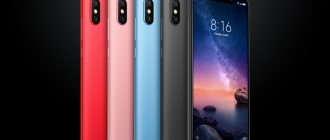When buying a Xiaomi smartphone from unofficial sellers, you need to have at least a minimal understanding of the technical nuances, know what lines of smartphones are on the market and understand how the global version of Xiaomi differs from the Chinese or other versions.
The company's portfolio of mobile devices is organized simply: a number of models are united by similar features and capabilities into separate families. For example, the Redmi Note series, whose devices are considered the best in terms of price/quality ratio. There are also budget phones, “just” Redmi, and the Mi line, which is positioned as a flagship, where they offer all the best: excellent speed, premium materials, decent photo quality and the latest fast charging technologies.
But there is something that all the company’s smartphones have in common - MIUI firmware. Perhaps this is one of the high-quality Android add-ons of all, where they manage to combine nice “tricks” with decent speed and stability of the shell under a pleasant interface.
At the moment, Miui is presented in several versions or “guises”. In this article we will talk about the following:
- How does the global version differ from the regular one?
- Let us explain what versions of Xiaomi exist;
- How to choose the right smartphone on AliExpress with the required firmware, so that you don’t regret what you’ve done.
Differences between the global version of Xiaomi and the Chinese one
Before purchasing a new phone, be sure to check what modification the seller offers for purchase . Just a couple of simple recommendations will allow you to distinguish between device versions.
Equipment and markings
One has only to look at the smartphone box, and it is immediately clear which version is inside. The packaging for the Chinese market has hieroglyphs , while the box for the global market has inscriptions in English . A sign that this is a variation for the international market is the Global Version label in red . Inside the package there is an instruction manual in the language of the country where the device is sold.
On the back of the smartphone there is also the inscription “Made in China” or “Made in India” , there is a company logo and you can find the model number.
Another sign of what variation of the gadget is in front of you is the charging adapter . The delivery set includes an original charging unit with flat pins for the Chinese market . to the European and global markets with a charger that already has a corresponding plug out of the box.
Region and Language
You can determine which version of the Xiaomi phone you have in front of you by checking the language pack . So, in China the choice of languages is limited to English and Chinese , for the rest of the world, including Europe - a full package of languages provided by Android.
Technical differences
There is a difference in hardware and characteristics . For example, in China they use a hybrid slot for a SIM card or microSD card , and also offer support for two SIM cards. While outside the Middle Kingdom they offer the same model with a separate slot for a microSD card or the ability to work with only one SIM card.
NFC
For quite a long time, Xiaomi smartphones were not equipped with such a function as NFC. The reason is simple - this wireless technology is not widespread or popular in China. But as devices expanded beyond the home market, they began to be equipped with NFC modules. It is considered the norm that models for the Chinese market do not have a chip for contactless payments , while global versions do.
LTE support
Chinese devices offer support for LTE bands at frequencies Band 1, 3, 5 and 7. For the international market they produce models capable of operating at frequencies Band 1, 3, 4, 5, 7 and 20. This means that the global version of Xiaomi is not able to correctly operate in fourth generation networks in China and a similar rule is valid for international modifications, but in the vastness of the Middle Kingdom.
Differences between Global ROM and Global Version
In online stores you can find Xiaomi smartphones, the description of which indicates the Global ROM firmware.
It is noted that there are pre-installed languages, Google applications and the ability to update the device officially. But this is not a genuine global firmware.
The difference is this:
- Global ROM is a type of device for use in China, in which the global firmware is added by the seller independently. The software specifications will correspond to international smartphones, while the hardware specifications will remain Chinese. Since unlocking was used for flashing, problems with banking services may arise.
- Global Version is the original version of the platform from the manufacturer. The firmware is official in accordance with the requirements of the European market.
What versions of Xiaomi smartphones are there?
It's time to explain what variations of smartphones are produced and why the company needed to divide them. The fact is that Xiaomi is struggling with resellers and shortages. To prevent cunning businessmen from buying up devices and thereby causing a shortage, and also to avoid an imbalance in the number of available devices in different markets, the company has introduced a division of devices into versions targeted at specific markets.
In addition, Google services are blocked in China , while outside this country users can no longer imagine a full-fledged smartphone without them. Support for cellular network standards , which vary in regions, is also important . The differences between versions of smartphones are also in the language packs installed on them.
Chinese version
Version for the Chinese market (China, Cn)
China ROM is a version intended exclusively for the Chinese market. It is replete with pre-installed applications targeting the preferences of users in the domestic market. to choose from : English and Chinese . And, perhaps most importantly, there are no Google services here and it is impossible to make contactless payments via NFC in the global market. And you can also forget about the warranty for a smartphone outside the Middle Kingdom.
It is also important which 4G LTE frequencies are supported. Thus, Chinese telecommunications companies do not work with fourth-generation networks in the 800 MHz band; there is no support for Band 20. Even if you try to reflash a Chinese device to the international MIUI shell, high-speed 4G Internet will not work in the LTE 800 coverage area.
However, reflashing a smartphone is now a quest . Gone are the days when just a few simple steps were required to roll a global card on any “Chinese”. From now on, you need to obtain permission, which will take several days, and with any careless movement there is a risk of getting a “brick” . But even if you manage to install the global version of the firmware, there is no guarantee that along with it the Xiaomi phone will not receive a number of problems and reduced functionality .
The advantage of China ROM is that smartphones with it on board are among the first to receive MIUI updates. While updates reach all other devices with a considerable delay.
Global ROM - modified Chinese version
Global ROM is a smartphone model aimed at the Asian market reflashed by the seller on Aliexpress. The reseller independently unlocked the bootloader and began installing the global version of the firmware. If in terms of software, it is practically no different from the Global Version, then the hardware limitations will not go away. This phone does not offer LTE b20 and there is a high probability that banking applications will not work correctly , which in turn will lead to the inability to make contactless payments .
Indian version
It is not difficult to guess that these are mobile devices that are aimed at the Indian market and are produced here. Xiaomi has several factories in the country on the banks of the Ganges River that assemble the company’s equipment. To increase the attractiveness of gadgets in this country, it has repeatedly flaunted the fact that smartphones are assembled in India and sold immediately.
Such mobile phones operate under the global version of MIUI, but with a number of differences in terms of pre-installed software. Smartphones are supplied in branded packaging, written in English, and there is always an inscription that they were made in India . You can determine that this is an Indian version, first of all, by the number of supported LTE frequencies. There are fewer of them than in China and on the world market.
Showing its loyalty to Indian consumers, Xiaomi often premieres its new smartphones in India, and subsequently they appear on the global market and directly in China. It also happens that they go outside India with different names and different memory configurations.
Russian version (Rostest)
In terms of software and hardware, smartphones are no different from global variations . The only trick is that they are labeled “Rostest” and certified by this department. They have official status and are available exclusively on the territory of the Russian Federation.
The Rostest marking means that they have identification codes (IMEI) and their warranty is valid throughout Russia; the user has the right to receive warranty service at any Russian certified center.
The disadvantage of such devices is that the price is on average 15-20% higher than for models sold on the “gray” market. Such devices are supplied legally, and the importer pays all necessary taxes and fees . The costs associated with the import of devices are included in the final price tag, and it is higher than what is asked for “gray smartphones.”
Global version
Devices available mainly on the European and American continents.
Xiaomi Global version, the key difference from other versions is:
- multilingual support, there is support for all languages offered by Android, including Russian. The translation is correct, the interface is free of incomprehensible signs and hieroglyphs;
- GSM Android or the full package of Google services is offered, access to the Google Play store;
- 4G LTE bands, 20 band present.
Support 4G aka LTE
Perhaps this is where the significant difference lies between phones for the Chinese and international markets. Although in fact, if you look into it a little more, you can understand how insignificant it is.
A little about technology.
Unlike GSM and UMTS, which have become the standards for 2G and 3G communications, LTE technology can use a much wider range of frequencies.
LTE technology can operate at frequencies from ultra-low frequencies of 450 MHz to ultra-high frequencies of 5 GHz, and what's more, it can combine multiple bands into one channel using LTE Advanced technology. In turn, these frequencies are divided into ranges, which are usually called “bands”.
There are a total of 70 LTE “bands”, which differ in frequency and some other parameters.
Currently, Russian operators use 5 bands:
- – 3 in the 1800 MHz FDD range;
- – 7 in the 2600 MHz FDD range;
- – 20 in the 800 MHz FDD range;
- – 31 in the 450 MHz FDD range;
- – 38 in the 2600 MHz TDD range.
Firmware modifications
A distinctive feature of MIUI is its several firmware options:
Stable ROM
Stable ROM is the official firmware of MIUI developers. It is stable, errors and bugs have been fixed . It is recommended for everyone to install it; it optimizes the operation of individual functions and the system as a whole, and also introduces a number of improvements and innovations. There is no clear release schedule.
Developer ROM
Developer ROM or developer firmware, which is created in the depths of Xiaomi and is aimed at geeks or enthusiasts who want to be among the first to try out the new functions of the proprietary shell. After it passes the closed testing stage and all the shortcomings are eliminated, it acquires the status of Stable ROM and is distributed to supported devices. Installation of Developer ROM occurs in two ways: fastboot and recovery.
MIUI Ported ROM
We are talking, first of all, about custom firmware from third-party developers . As a rule, they are released in countries where there is no official support for devices. For example, in Vietnam. The first clear sign that this is third-party software is that when the device boots, the logo of the team that created the firmware appears on the screen.
Poor quality custom builds
The openness of Android and the fact that Xiaomi publishes firmware sources opens up opportunities for device customization, including installing third-party firmware. There are really high-quality custom ones that expand the functionality of smartphones.
But there is always a chance to run into software that will turn into a headache. There is a high risk of getting a “pack” of bugs or a “brick” , and the owner also loses the warranty on the device. Often, installing custom firmware will disable a number of functions, there may be a deterioration in the autonomy and stability of the smartphone , and you should not count on stable support and timely receipt of updates.
Local MIUI ROM, etc.
MIUI ROM - firmware designed to work in the networks of a specific cellular operator . Most often we are talking about WCDMA ROM MIUI and TD ROM , where the first is focused on working in 3G WCDMA networks, and the second is on models for the Chinese market.
Based on the size of the firmware, they are classified:
- Full ROM. They put it on “clean” mobile phones. Contains all key services and eliminates errors that could not be resolved in the usual way;
- Incremental ROM is an “appendage” or addition to MIUI. The main task is to eliminate errors.
Classification by type
1. Weekly (Developer ROM).
The most popular type of firmware, since all the latest changes can be obtained through its use. It is an official legacy from the developer Xiaomi. Generally, updates occur every week until Friday, excluding Chinese public holidays. Often, if there are errors in the new firmware, then do not worry, since they will be fixed in the next weekly update
2. Stable (Stable ROM). As in the first version, it is the official creation of the Chinese developer MIUI (a protégé of Xiaomi). However, there is a difference: this firmware contains exclusively measured parameters and functions, the operation of which is maximally debugged. The best option for those who are not chasing new bugs and are not testing technical innovations
An important difference from other versions of global firmware is inconsistent updates, since it uses exclusively well-established mechanisms
3. Unofficial, custom (Ported ROM).
Built on many functions and programs that were created by third-party specialists. Standard, proven firmware is used as the basis. In this case, updates do not occur constantly, so it is impossible to calculate a specific date. Sometimes the interval is up to several months
4.Samopal.
It is not an independent category of global firmware. As a rule, these firmwares are presented at the lowest possible cost, since they are assembled by amateurs with numerous errors, an inconvenient interface, and poor-quality translation. Since the quality of this type leaves much to be desired, it is most reasonable to use one of the three options presented above
How to determine what firmware version you have?
In order to understand which firmware version is installed on the gadget, follow the path: “Settings” - “About phone” - MIUI version . Another way is to determine (special identifier) is present or missing We go to the “About phone” , go to “All parameters” then to “General information” , where the presence of the abbreviation MEID next to IMEI indicates that this is a “Chinese” phone.
conclusions
After reading a “ton” of text, the main conclusion to come to is that it is better to give preference to the global version of Xiaomi and not to “dance with a tambourine” in order to reflash the “Chinese” to Global ROM. Yes, purebred “Chinese” ones are cheaper on AliExpress, but in order to be comfortable working with them, you have to download the appropriate software and Google services, and also say goodbye to the warranty.
Therefore, pay a little more, but you will receive a device that is functional and adapted for our latitudes with a guarantee . If you are planning to buy a Xiaomi smartphone, then do not neglect our advice. Check the packaging, equipment, firmware version and supported LTE bands so as not to miss the choice.











